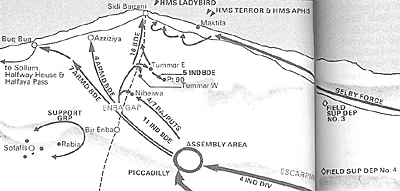Wavell now ordered O'Connor to carry a five-day raid on the Italian army as soon as possible. Wavell suggested to split his forces and attack the Italian flanks, with an enveloping movement in the south. But O'Connor had other ideas. First of all, O'Connor argued, that the terrain to the south of enemy positions was unsuitable for tanks so the plan would not work as a lot depended on tank mobility, and secondly attacking on two different axis by splitting the already small forces would create more problems.
O'Connor considered the Italian deployment around Sidi Barrani to be extremely unsound. The Italian Tenth army had made a series of fortified fixed forward line positions from Maktila which is on the coast some fifteen miles east of Sidi Barrani. These camps stretched from Maktila fifty miles inland to Sofafi. These were defended by a group of Libyan divisions which numbered some three divisions with tanks mixed with the infantry.
Behind this line, at Sidi Barrani, was a division and part of another. Further back were the 21st and 23rd Corps which contained some five divisions between them. In the forward positions there was a gap between Sofafi and Nibeiwa camps, and it would be this gap which O'Connor would exploit to the fullest.
 O'Connor's plan was to penetrate the gap between Sofafi and
Nibeiwa to cut the Italian defences in two. Then he would swing north, behind the
Italian front and attack the enemy in the rear. This would cut the enemy's
lines of communications and Sidi Barrani would fall.
O'Connor's plan was to penetrate the gap between Sofafi and
Nibeiwa to cut the Italian defences in two. Then he would swing north, behind the
Italian front and attack the enemy in the rear. This would cut the enemy's
lines of communications and Sidi Barrani would fall.
Map: from The Crucible of War, page 94-5.
For this attack, O'Connor had two divisions. They were the 4th Indian infantry division, with the fifty-seven 'I' tanks, and the 7th Armoured Division. plus, there was a small force called the 'Selby Force' named after its brigadier. The total command numbered some thirty-six thousand men, 120 guns and 275 tanks.
The airforce which was to co-operate with O'Connor was under the command of Wing-Commander R. Collishaw, whose mission was to carry out continuous attacks on the enemy airfields in order to destroy Italian planes and support vehicles on the ground.
The 4th Indian infantry division was under the command of General N.m de la P. Beresford-Peirse and the 7th Armoured Division was under General Michael Creagh. The final orders for Operation Compass, the code-word for this operation, were given on 5th December by Wavell.
Operation Compass
So when it was full daylight on 9th December,1940, the Western Desert force attacked. The 4/7th Rajput Regiment started to fire on Nibeiwa from the east, while the 'I' tanks of the 7th royal tank regiment along with infantry moved through the south of the camp, turned towards north in its rear and then delivered a attacking stroke north-west corner of the camp. The Italians were surprised but on the whole fought courageously. Their camp commander, General maletti was killed in battle. O'Connor's men captured two thousand Italians plus thirty five medium tanks, while losing only fifty-six men.
Without losing any time, the 4th Indian division and the 'I' tanks attacked Tummar West from north-west. Tummar West fell rather quickly and the Western Desert moved against Tummar East. O'Connor was, as usual, forward with his troops. Two days earlier, General Creagh was admitted to the hospital for he had an abscess on his tongue. His command was taken over by Brigadier 'Blood' Caunter. Caunter moved his light tanks across the coast road between Sidi Barrani and Buq Buq to cut the enemy's retreat.
 The next morning, Tummar East fell. The Selby Force made a frontal attack on
prepared Italian positions while the 7th Armoured Division moved further
west across the rear to trap the Italians. Two Italian divisions were
encircled near Sidi Barrani and by 11th December it was all over.
The next morning, Tummar East fell. The Selby Force made a frontal attack on
prepared Italian positions while the 7th Armoured Division moved further
west across the rear to trap the Italians. Two Italian divisions were
encircled near Sidi Barrani and by 11th December it was all over.
At right, Selby, from The Crucible of War
Thirty-eight thousand Italian prisoners were taken, the equivalent of two Italian corps, plus four Italian generals, seventy-three tanks and some two hundred and thirty-seven guns all went into British hands. This remarkable victory was achieved at the cost of only six hundred and twenty-four western desert force casualties.
Then came the news that the 4th Indian division would be leaving O'Connor's command for other operations. Now O'Connor had two options open to him-- either fall back to Matruh as originally planned or pursue the enemy with the forces available. As was characteristic of O'Connor he choose the latter option. He was determined to pursue the Italians as soon as possible to exploit the situation to the fullest.
He ordered the 4th Armoured Brigade to move through the escarpment with a flanking movement on a tactical level while the 7th Armoured Brigade was ordered to move rapidly on the coast road. The rapidity of the British advance trapped the Italians, and as a result the Italians fell back into the fortress of Bardia.
More General Richard O'Connor: British Western Desert Force
Back to Table of Contents -- World War Two Newsletter
Back to World War Two Newsletter List of Issues
Back to MagWeb Magazine List
© Copyright 2001 by Shahram Khan.
This article appears in MagWeb (Magazine Web) on the Internet World Wide Web.
Other military history articles and gaming articles are available at http://www.magweb.com